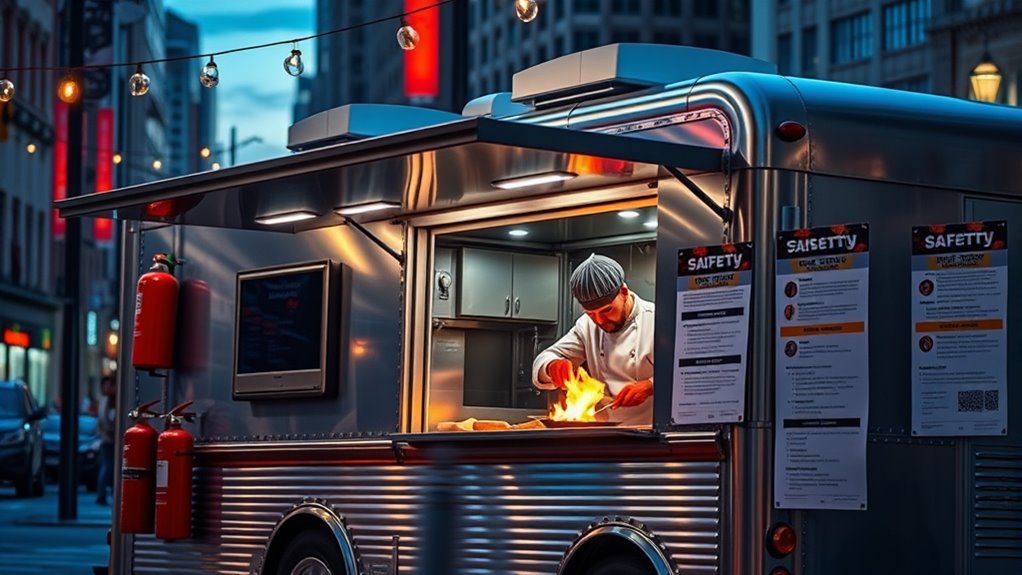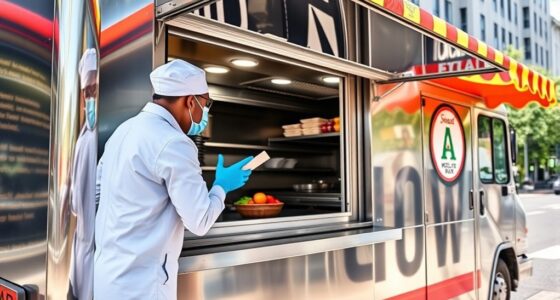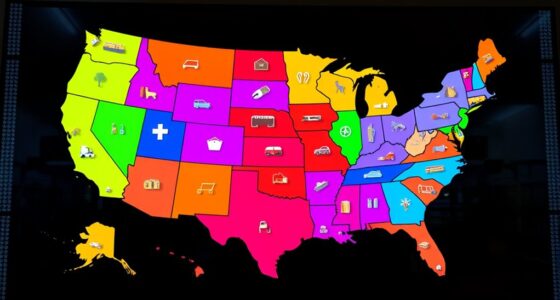To navigate fire safety regulations for food trucks, start by understanding local codes and obtaining necessary permits. Install and regularly maintain fire suppression equipment, like extinguishers and automatic systems, ensuring they are accessible and functional. Practice safe cooking by avoiding overfilled fryers and keeping safety devices nearby. Train your staff on emergency procedures and conduct routine inspections to stay compliant. If you keep these steps in mind, you’ll be well-prepared to meet safety standards and protect your business—more guidance lies ahead.
Key Takeaways
- Stay updated with local fire department regulations and inspection procedures for mobile food units.
- Install and regularly inspect accessible, properly rated fire extinguishers and suppression systems tailored for food trucks.
- Train staff on fire safety protocols, proper equipment use, and emergency response procedures.
- Conduct routine safety audits, including signage, equipment checks, and compliance documentation.
- Develop and rehearse emergency plans, evacuation routes, and communication protocols specific to food truck operations.
Understanding Local Fire Codes and Permits
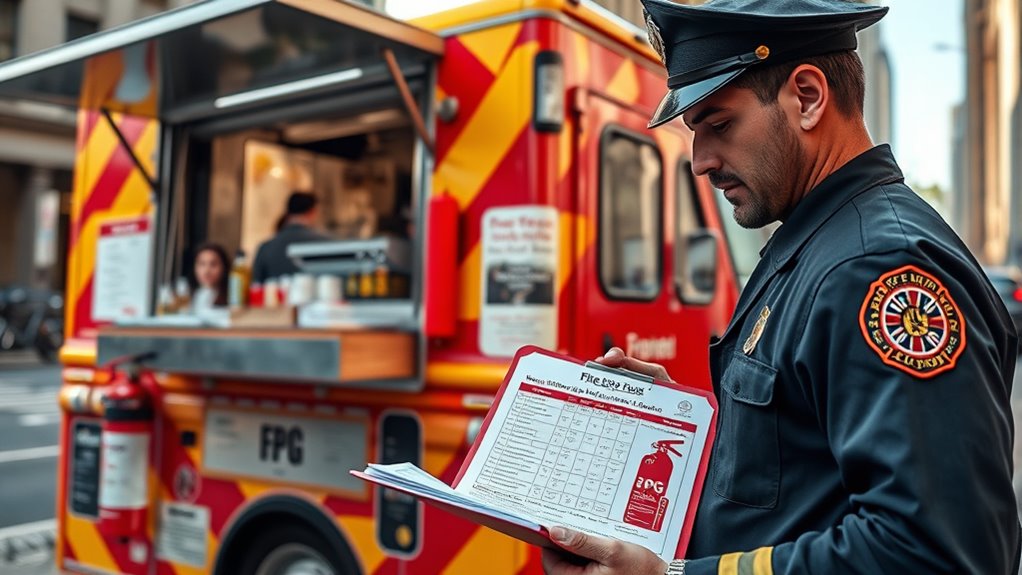
To guarantee your food truck operates safely and legally, you need to understand and comply with local fire codes and permit requirements. Staying informed about fire code updates is essential because regulations can change frequently, affecting how you operate. Check with your local fire department or regulatory agency to learn about specific fire safety standards and recent updates. The permit application process typically involves submitting detailed plans of your truck’s layout, fire suppression systems, and safety equipment. It’s crucial to follow these steps carefully to avoid delays or fines. Ensuring your permits are approved before launching helps you stay compliant and safe. Regularly reviewing fire safety regulations and maintaining your safety equipment ensures your food truck remains compliant with evolving regulations. Additionally, understanding the inspection procedures can help you prepare adequately for official reviews. Staying up-to-date with regulatory changes and conducting routine safety audits can prevent violations and promote a safer working environment. Remember, understanding and adhering to fire codes and permit procedures is a fundamental part of running a successful food truck, especially when you keep abreast of local safety standards.
Essential Fire Suppression Equipment for Food Trucks
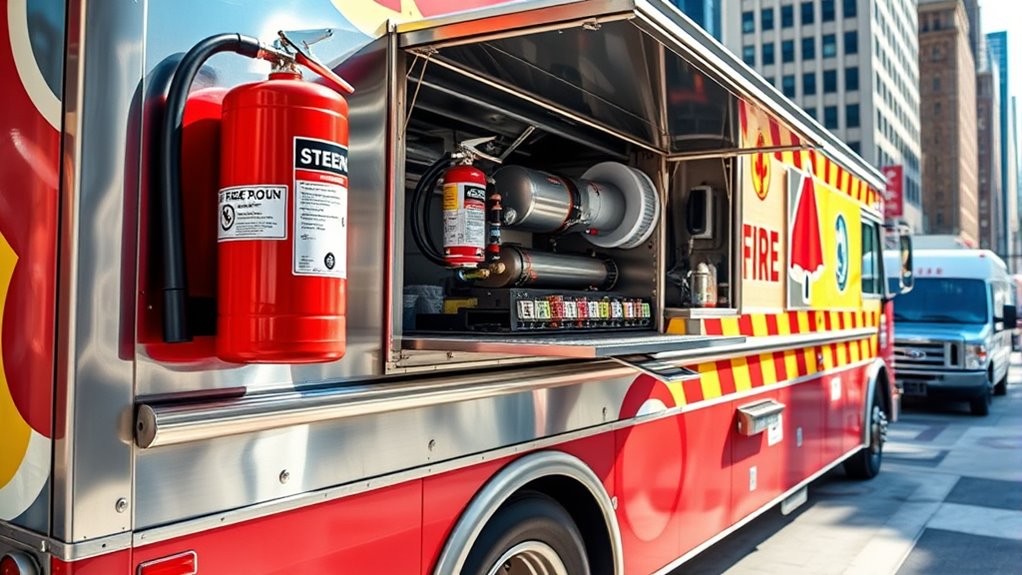
What fire suppression equipment does your food truck need to stay safe and compliant? You must have a properly rated fire extinguisher placed in a visible, accessible spot, guaranteeing easy reach during emergencies. Regularly check fire extinguisher placement to confirm it’s within easy reach and not blocked. Additionally, your truck needs an automatic suppression system designed for commercial kitchens, which must undergo routine suppression system inspection to verify it functions correctly. These inspections ensure the system activates promptly when needed, preventing fires from spreading. Having the right fire suppression equipment in place isn’t just about compliance—it’s about protecting yourself, your staff, and your customers. Regular maintenance and proper training on the use of fire suppression tools are crucial for effective emergency response. Incorporating Fire safety measures into your routine checks is essential to maintain readiness, making sure your truck is prepared for any fire emergency. Being aware of merchant services risks can also help you choose fire safety solutions that are both reliable and cost-effective. Additionally, understanding the contrast ratio of your fire suppression system can help you evaluate its effectiveness in various fire scenarios. Selecting fire suppression equipment with appropriate fire resistance ratings ensures optimal protection in different fire situations. Integrating aesthetic considerations into safety equipment placement can also enhance overall visibility and accessibility during emergencies.
Proper Installation and Maintenance of Fire Safety Devices
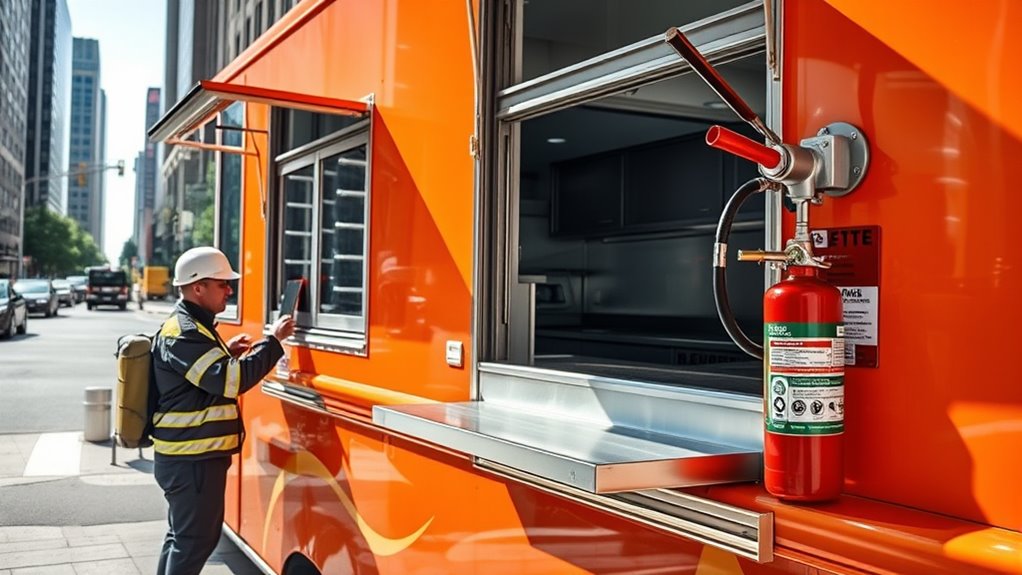
Proper installation and regular maintenance of fire safety devices guarantee they function effectively when needed. You must ensure fire extinguishers are correctly mounted and easily accessible, following manufacturer instructions. Know the different fire extinguisher types, like ABC and CO2, to select appropriate options for your food truck. Regularly check and follow maintenance schedules, including monthly inspections for leaks, pressure, and damage. Replace or recharge extinguishers as needed to ensure maximum effectiveness. Keep fire safety devices free from obstructions and verify they are visibly and clearly labeled. Properly installed and maintained devices can prevent fires from escalating, protecting your truck and customers. Routine inspection protocols help identify potential issues early, ensuring ongoing safety and compliance. Regular training on fire safety procedures ensures everyone onboard responds effectively during emergencies. Conducting regular inspections and keeping detailed records help maintain compliance and readiness. Remember, consistent upkeep is essential to stay compliant and safe on the road. Using vetted fire safety products ensures reliability and compliance. Additionally, consulting with fire safety experts can help you select the most suitable safety devices for your specific food truck setup.
Safe Cooking Practices to Minimize Fire Risks
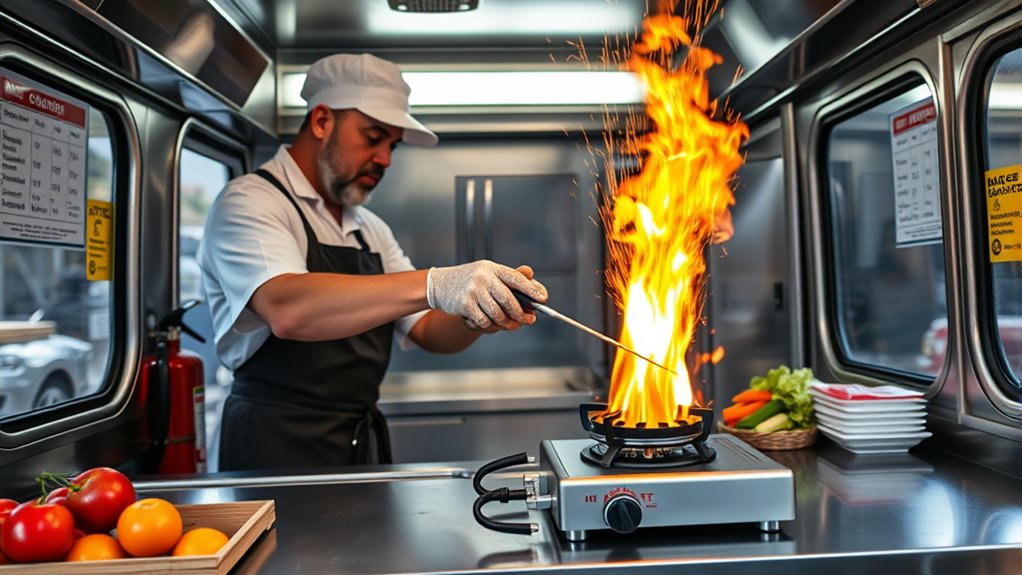
Implementing safe cooking practices is essential to reducing fire risks in your food truck. One key aspect is proper cooking oil management—avoid overfilling fryers and never leave hot oil unattended. Regularly check oil levels and dispose of used oil securely to prevent buildup that can ignite. Using fire-resistant materials for countertops and splash zones adds an extra layer of protection, reducing the chance of flames spreading. Keep fire extinguishers nearby and ensure all cooking equipment is well-maintained to prevent leaks or malfunctioning parts that could spark fires. Always stay attentive when frying or grilling, and avoid loose clothing that could catch fire. Additionally, staying informed about fire safety regulations can help you implement comprehensive safety measures, ensuring compliance and safety in your operation. Incorporating modern safety standards, such as updated fire suppression systems, further reduces the risk of fire hazards. Staying current with fire safety laws is crucial for maintaining a safe working environment. Furthermore, implementing body awareness techniques can help staff stay alert to potential hazards, minimizing accidents. Regular training on fire prevention can also enhance staff readiness and response in emergencies. These practices help minimize fire hazards, keeping you, your staff, and your customers safe.
Employee Training and Emergency Response Procedures
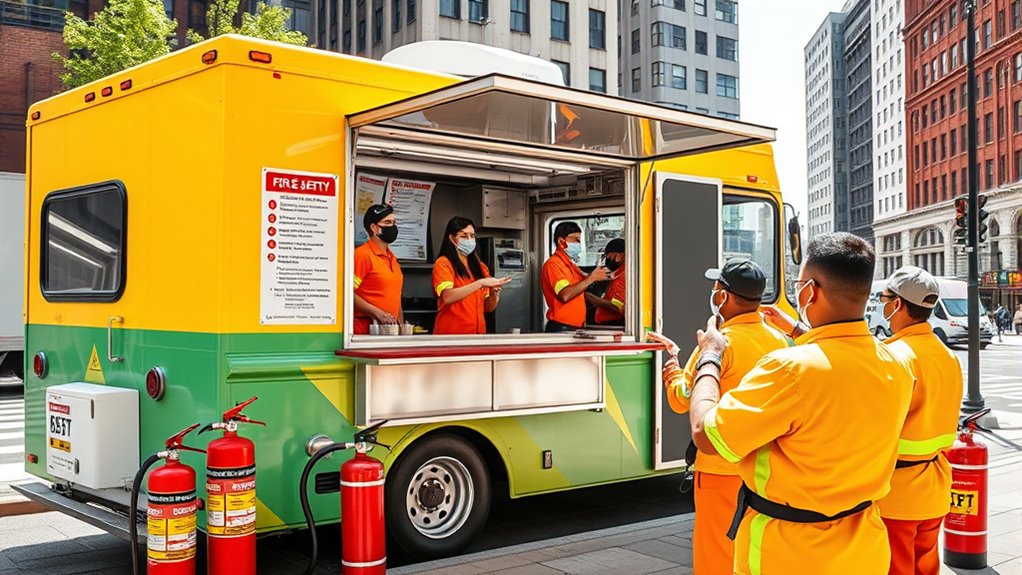
You need to guarantee your staff receives proper safety training and understands emergency procedures. Developing a clear emergency response plan helps everyone react quickly if a fire occurs. Regular drills keep your team prepared and reinforce safety protocols effectively. Incorporating fire safety regulations into your training ensures compliance and enhances overall safety measures. Educating staff about essential oils for fire prevention can also contribute to safety awareness in your food truck operations. Additionally, understanding holistic approaches to health and wellness can promote overall safety and well-being among your team members. Emphasizing comprehensive safety education ensures that all team members are confident and knowledgeable in handling emergency situations.
Safety Training Requirements
Have you ever wondered how food truck operators guarantee their staff is prepared for emergencies? Proper safety training is essential. You must verify your team has the necessary fire safety certifications and hazard awareness to prevent accidents. Regular training sessions reinforce safe practices, like using fire extinguishers and handling flammable materials. It’s important that employees understand how to respond swiftly in case of a fire.
Key safety training components include:
- Obtaining and maintaining fire safety certifications
- Recognizing fire hazards specific to food trucks
- Demonstrating correct fire extinguisher use
- Identifying emergency shutdown procedures
- Conducting periodic hazard awareness refreshers
This training helps reduce risks and ensures everyone stays prepared, maintaining compliance with fire safety regulations.
Emergency Response Planning
How well-prepared are your staff members to respond swiftly in an emergency? Ensuring they know fire drill procedures is essential for safety. Regular training helps your team act confidently during a fire or other incidents, minimizing chaos. Clear emergency communication is critical; everyone should know who to alert and how to relay information efficiently. You need to establish a plan that details evacuation routes and roles, so staff can react quickly without hesitation. Practice these procedures regularly to reinforce their importance. When everyone understands their responsibilities, response times improve, reducing risks. Remember, a well-trained team can prevent injuries, contain fires faster, and keep customers safe. Prioritizing emergency response planning creates a safer environment and helps your food truck comply with fire safety regulations.
Regular Drills Implementation
Implementing regular drills is crucial to guarantee your staff remains prepared for emergencies. Conducting fire drill procedures helps identify weaknesses and ensures everyone understands their role during a crisis. These drills improve emergency communication, so staff can quickly relay important information and coordinate responses. Regular practice builds confidence and reduces panic during actual incidents. To maximize effectiveness, consider these key points:
- Schedule drills at different times to simulate real scenarios
- Review fire drill procedures regularly with your team
- Use clear, concise emergency communication signals
- Assign specific roles and responsibilities
- Debrief after each drill to discuss improvements
Regular Inspections and Staying Compliant With Regulations
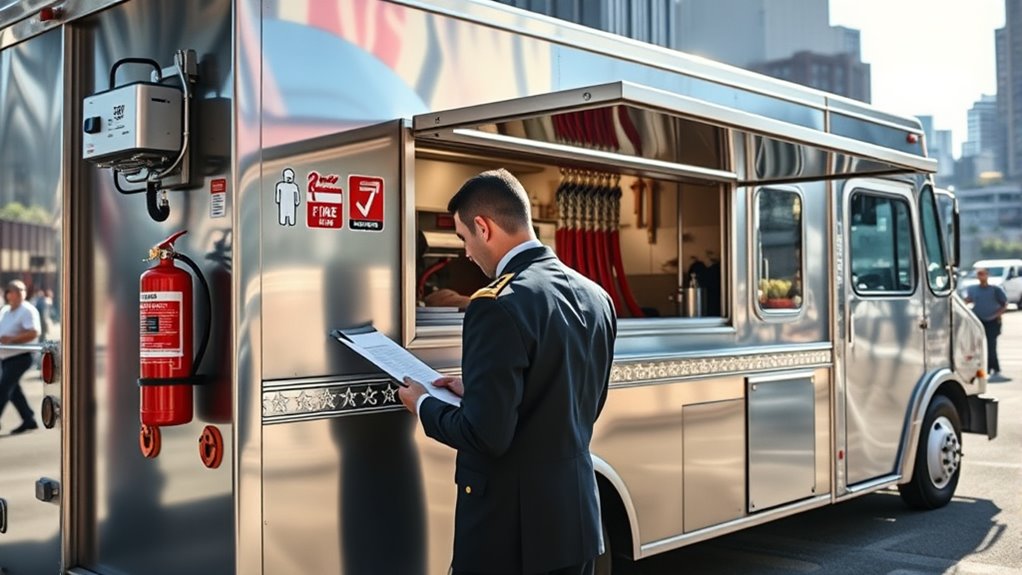
To guarantee your food truck remains compliant with fire safety regulations, regular inspections are essential. You should routinely check that your fire safety signage is visible and up-to-date, ensuring everyone knows what to do in an emergency. Proper fire extinguisher placement is vital; verify that extinguishers are easily accessible, mounted correctly, and in working condition. During inspections, look for any signs of damage or obstruction that could hinder safety equipment. Staying compliant also means keeping records of inspections and maintenance. By proactively monitoring these aspects, you reduce the risk of fines or violations and improve safety for yourself and your customers. Regular inspections keep your food truck prepared, compliant, and ready to handle emergencies effectively.
Frequently Asked Questions
How Often Should Fire Safety Equipment Be Inspected and Serviced?
You should follow a regular inspection schedule for your fire safety equipment, typically monthly, to guarantee everything functions correctly. Use a maintenance checklist to verify that fire extinguishers, alarms, and suppression systems are in top condition. Regular inspections help you catch issues early, maintain safety standards, and comply with regulations. Make sure to document each inspection, and schedule professional servicing as needed, usually annually or after any use or damage.
What Are the Penalties for Non-Compliance With Fire Safety Regulations?
Imagine a fire safety alarm echoing through your food truck just as a fire safety inspector arrives—your compliance matters. If you overlook regulations, you risk hefty fire safety fines and regulatory penalties that can shut down your business. Staying compliant prevents unexpected costs, keeps your customers safe, and ensures your operation runs smoothly. Don’t let neglect turn into a costly mistake—prioritize fire safety and avoid unnecessary fines.
Can I Operate Without a Fire Suppression System in Small Food Trucks?
You can’t operate a small food truck without a fire suppression system if safety compliance regulations require it. Fire suppression systems are essential for preventing fires from spreading quickly and ensuring your safety and that of your customers. Always check local fire safety codes, and if a fire suppression system is mandated, installing one is vital. Ignoring this regulation puts you at risk of penalties and endangers lives.
Are There Specific Fire Safety Requirements for Mobile Food Carts Versus Trucks?
You’re asking if fire safety rules differ between mobile food carts and trucks. The answer is yes, they often have distinct requirements. For example, fire extinguisher placement must be accessible and clearly marked, and ventilation requirements vary based on size and setup. You need to guarantee both meet local codes, so don’t leave any stone unturned. Remember, it’s better to be safe than sorry when it comes to fire safety!
How Do I Handle Fire Emergencies if the Fire Suppression System Malfunctions?
If your fire suppression system malfunctions, stay calm and act quickly. Use your fire extinguisher to tackle small fires and guarantee you’ve conducted regular fire extinguisher drills to stay prepared. Follow your emergency evacuation plan to safely exit the vehicle if needed. Always communicate with your team, and ensure everyone knows their roles during a fire emergency. Regular practice and clear plans make handling malfunctions much safer.
Conclusion
So, after all this, you might think fire safety is just another paper chase. But remember, neglecting these regulations could turn your food truck into a fiery disaster. Ironically, the very safety measures you ignore could be the difference between serving up delicious meals and a fiery catastrophe. Stay vigilant, follow the rules, and keep your customers safe—because nothing says success like a fireproof food truck and a spotless safety record.
